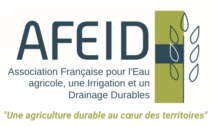“Brazilian type" underground dam (with plastic film)
Innovation field
Initially developed in North-East Brazil and spread to Chad and Sudan.
Summary
An alluvial groundwater dam stops groundwater flow in the permeable alluvium of intermittent river beds. It thus builds up water reserves that allow wells to remain productive longer after the rainy season.
This technique has been around for a long time. The innovation lies in the very simple use of a plastic film, available at a low cost and easy to set up by a community.
Emergence of the innovation
EMBRAPA, the Brazilian Agricultural Research Corporation, Brazil
In ancient granitic or metamorphic areas, only the cracked areas in the bedrock can constitute small groundwater reservoirs. These areas are rare, difficult to reach and the water is more salty and not well accepted, even if it is very safe from a health point of view.
The idea was therefore to find a quality water resource, one that was easier to mobilise and available permanently or for most of the dry season.
Solution(s) provided by the innovation
In arid or semi-arid climates, water remains after the rains in the often sandy alluvial deposits of intermittent river beds. This "alluvial" water is generally of good quality and quite easy to use (shallow wells) but the water continues to flow into the alluvium after the end of the rainy season and disappears after a few months. These resources, because they are lacking every year for several months at the time when they are most needed, are not considered for irrigation and do not fully solve the water problems of families and their animals.
An underground dam in the alluvium makes it possible to stop these underground flows (inferoflux) and to constitute a water reserve which allows the wells to supply water much longer and often until the beginning of the rainy season. Its implementation requires the presence of a watertight base, often made of ancient non-fractured rock (bedrock) or clay. This technique has existed for a long time with masonry dam solutions or with a clay core.
Une technique mise au point par les chercheurs dans le Nordeste Brésilien dans les années 90, montre qu’un simple film plastique (PE de plus de 200 microns d’épaisseur) placé en travers des alluvions jusqu’à être « collé » à la base imperméable (socle rocheux ou couches argileuses), est peu couteuse, efficace et stable quelque soient les crues. En interrompant l’inféroflux elle stocke des réserves d’eau dans les alluvions, à l’abri de l’évaporation, des pollutions et des dégâts lors des crues. Cette ressource constitue une nouvelle ressource semi-souterraine de grande valeur surtout pour les zones de climat aride et/ou semi-aride.
Depending on the volume stored, these dams can be used either for human and animal use only, or, for the largest ones, to supply small cultivated areas of a few hectares.
Underground dams can be located one after the other along the same intermittent river, thus multiplying successive semi-subterranean reservoirs that do not compete with one other. It is important to check whether larger dams of this type can be developed for small and medium-sized cities and for irrigation. With the right choice of sites, the volume of the reserves can allow for irrigation of different scales. The water stored in the alluvium can be obtained from a large diameter well in the center of the alluvium or laterally, upstream of the underground dam (pre-existing or built after the underground dam).
History of evolution since emergence (implementation on the field)
En dehors des diffusions de grande ampleur dans le Nordeste Brésilien (zone de socle cristallin Paraiba, Pernambuco, Ceara,…) à partir des années 90, seules les expériences depuis 2019 et 2020 au Tchad (Guera) et au Soudan (Darfour) semblent connues. Au NE brésilien chaque barrage souterrain « familial » est utilisé surtout pour des cultures sur de petites surfaces de 1 à 3 hectares mais ils sont des milliers. Au Tchad et au Soudan pour l’instant il n’y a pas encore de projets d’irrigation, mais quelques-uns pour l’alimentation en eau potable et l’abreuvement du bétail
Users' opinions / elements of acceptance of the innovation
Users enthusiastically accept the innovation after noting:
1) the effectiveness of the technique,
2) its very easy implementation,
3) its very low cost,
4) its high durability (the plastic film buried in the sun could be effective for 200 years and if necessary, placing another film upstream or downstream would be easy),
5) the possibility of making successive dams in the same river without difficulty,
6) the adaptability of the technique to areas with sufficiently clayey soils (not only continuous rocks).
The difficulties for users are:
- the absence of visibility: water from surface dams is visible and immediately accessible, and therefore socially and politically much more appreciated (even though they are very expensive, fill up quickly with soil and are often threatened by exceptional floods, and have a significant area take on the richest lands,...);
- doubts about the quality of the water (even although the populations much prefer to drink the water from the sands and to use the salty water from the wells equipped with hand pumps for washing clothes, and the health services suggest adding chlorine when families drink water from the ponds but not for the underground water).
Economic assessment of the innovation
Estimated costs of the first underground dam in Chad: (underground dam of 50 to 70 m long, depth 1.8m; stored volume of about 10 to 15,000 m3 over 200 m of river):
- Supplies : <100€ (plastic sheet + cement)
- Labour: 2200 d*2€ = 4400€.
Prospects for the evolution of the innovation
This technique could be replicated in many semi-arid contexts in ancient impermeable basement areas and intermittent sandy riverbeds.
Depending on the depth of the bed, and in less populated areas, the use of mechanised earth moving (backhoe loader) could become necessary.
Conditions for the dissemination of the innovation and replicability
The manual installation technique has not been tested on larger dams, which would allow for greater volumes of water to be stored. Above a certain trench size, mechanical means must be used.
Need for dissemination of information, training of users and technicians.
Need to set up rules for the good management of the resource thus created.
Associated risks, negative externalities
Difficultés rencontrées :
- The lack of scientific and technical references due to the innovative nature of this solution.
- The crystalline rock base must be continuous and totally impermeable. The plastic film "glued" to the bottom of the alluvium must not let any water flow through (no infiltration deep in the hydraulic basin and no leakage on the bottom or sides of the dam). In one of the six experiments (Wadi Fira province), the water would not have been correctly stored (construction defect or faults in the rocky part?).
- The water, which is totally lacking for a long period, is used for all sorts of needs (drinking, cooking, hygiene, watering animals, making bricks, etc.), which creates a number of management difficulties (drinkability due to the containers used in the well, which can pollute the water drawn, competition, etc.).
- The need for "local" training of the population on the choice of sites and construction techniques (it is useful to use augers to know the depth of the alluvium beforehand, to check the volumes and qualities of sand that will constitute the reservoirs, techniques for sticking the plastic film, etc.).
- Some criticise the use of plastic film for ecological reasons (risks due to the dissemination of micro-plastics and the possible release of harmful products into the soil by the plastic films). But these possible chemical pollutions seem low enough not to have to worry about the possible consumption of the water by the populations).
Additional documentation
Barragens subterraneas (Brésil): CPATSA/EMBRAPA : https://www.cpatsa.embrapa.br
SAND DAMS (Kenya): www.waterforaridland.com, http://practicalaction.org/practicalanswers/ , www.rainfoundation.org
Video on use in sandy areas like Guéra in Chad: https://www.dropbox.com/sh/8sd1te92donrh2z/AABGME0SlhBcYfnuK_u89drya?dl=0




Leave a Reply
Want to join the discussion?Feel free to contribute!